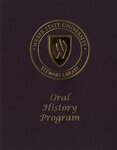| Title |
Kawamura, Diane OH19_018 |
| Creator |
Weber State University, Stewart Library: Oral History Program. |
| Contributors |
Kawamura, Diane, Interviewee; Harris, Kandice, Interviewer; Flinders, Tanner, Video Technician |
| Description |
The Beyond Suffrage Project was initiated to examine the impact women have had on northern Utah. Weber State University explored and documented women past and present who have influenced the history of the community, the development of education, and are bringing the area forward for the next generation. The project looked at how the 19th Amendment gave women a voice and representation, and was the catalyst for the way women became involved in the progress of the local area. The project examines the 50 years (1870-1920) before the amendment, the decades to follow and how women are making history today. |
| Abstract |
The following is an oral history interview with Dr. Diane Kawamura, conducted on March 8, 2019 in the Stewart Library's University Archives Conference Room, by Kandice Harris. Diane discusses her life, her memories at Weber State University, and the impact of the 19th Amendment. Tanner Flinders, the video technician, is also present during this interview.; The following is an audio clip of an oral history interview with Dr. Diane Kawamura, conducted on March 8, 2019. In this video clip, Diane discusses the gender differences in nursing education in the 1960s. |
| Subject |
Voting--United States; Women--suffrage; Women--Rights of women; Universities and colleges; Women in higher education; Universities and colleges--Faculty; Women college administrators; Radiology; Medical radiology; Medical radiology--Practice; Medical radiology--Instruments |
| Keywords |
Female medical educators; Women in medicine; Voting right; The 19th Amendment |
| Digital Publisher |
Stewart Library, Weber State University, Ogden, Utah, United States of America |
| Date |
2019 |
| Date Digital |
2019 |
| Medium |
oral histories (literary genre) |
| Spatial Coverage |
Aberdeen, City of Aberdeen, Brown, South Dakota, United States, http://sws.geonames.org/5225857, 45.4647, -98.48648; Sioux Falls, City of Sioux Falls, Minnehaha, South Dakota, United States, http://sws.geonames.org/5231851, 43.54997, -96.70033; Ogden, Weber County, Utah, United States, http://sws.geonames.org/11788968, 41.22809, -111.96766 |
| Type |
Text; Image/StillImage; Image/MovingImage |
| Access Extent |
60 page PDF; Video clip is an mp4 file, 41.5 MB |
| Conversion Specifications |
Filmed using a Sony HDR-CX430V digital video camera. Sound was recorded with a Sony ECM-AW3(T) bluetooth microphone. Transcribed using Express Scribe Transcription Software Pro 6.10 Copyright NCH Software. |
| Language |
eng |
| Rights |
Materials may be used for non-profit and educational purposes, please credit University Archives; Weber State University |
| Source |
Kawamura, Diane OH19_018 Weber State University Archives |
| Format |
application/pdf; video/mp4 |
| ARK |
ark:/87278/s6c0x06v |
| Setname |
wsu_bs_oh |
| ID |
105430 |
| Reference URL |
https://digital.weber.edu/ark:/87278/s6c0x06v |
| Title |
Kawamura, Diane OH19_018 |
| Creator |
Weber State University, Stewart Library: Oral History Program. |
| Contributors |
Kawamura, Diane, Interviewee; Harris, Kandice, Interviewer; Flinders, Tanner, Video Technician |
| Description |
The Beyond Suffrage Project was initiated to examine the impact women have had on northern Utah. Weber State University explored and documented women past and present who have influenced the history of the community, the development of education, and are bringing the area forward for the next generation. The project looked at how the 19th Amendment gave women a voice and representation, and was the catalyst for the way women became involved in the progress of the local area. The project examines the 50 years (1870-1920) before the amendment, the decades to follow and how women are making history today. |
| Abstract |
The following is an oral history interview with Dr. Diane Kawamura, conducted on March 8, 2019 in the Stewart Library's University Archives Conference Room, by Kandice Harris. Diane discusses her life, her memories at Weber State University, and the impact of the 19th Amendment. Tanner Flinders, the video technician, is also present during this interview. |
| Image Captions |
Diane Kawamura 2019 |
| Subject |
Voting--United States; Women--suffrage; Women--Rights of women; Universities and colleges; Women in higher education; Universities and colleges--Faculty; Women college administrators; Radiology; Medical radiology; Medical radiology--Practice; Medical radiology--Instruments |
| Keywords |
Female medical educators; Women in medicine; Voting right; The 19th Amendment |
| Digital Publisher |
Stewart Library, Weber State University, Ogden, Utah, United States of America |
| Date Digital |
2019 |
| Medium |
oral histories (literary genre) |
| Spatial Coverage |
Aberdeen, City of Aberdeen, Brown, South Dakota, United States, http://sws.geonames.org/5225857, 45.4647, -98.48648; Sioux Falls, City of Sioux Falls, Minnehaha, South Dakota, United States, http://sws.geonames.org/5231851, 43.54997, -96.70033; Ogden, Weber County, Utah, United States, http://sws.geonames.org/11788968, 41.22809, -111.96766 |
| Type |
Text; Image/StillImage |
| Access Extent |
60 page PDF |
| Language |
eng |
| Rights |
Materials may be used for non-profit and educational purposes, please credit University Archives; Weber State University |
| Source |
Kawamura, Diane OH19_018 Weber State University Archives |
| Format |
application/pdf |
| Setname |
wsu_bs_oh |
| ID |
105549 |
| Reference URL |
https://digital.weber.edu/ark:/87278/s6c0x06v/105549 |





